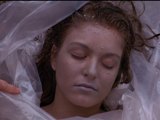 |
Twin Peaks
Episode 0A: "Wrapped in Plastic"
(0:00-44:11 of the 90-minute
pilot episode)
TV episode
Written by Mark Frost and David Lynch
Directed by David Lynch
Originally aired April 8, 1990
Page last updated 1/4/2022
|
In the small, seemingly innocent
Washington town of Twin
Peaks, a bizarre and murderous series of
events sends FBI Special Agent Dale Cooper to investigate, where
he encounters unusual characters and strange goings-on.
(This episode begins with the morning at
the Packard's Blue Pine Lodge home and ends with Cooper
discovering the letter "R" under Laura Palmer's fingernail and
telling Sheriff Truman they have a lot to talk about.)
Read the complete pilot episode transcription at Glastonberry.net
Didja Know?
For the titles of the Twin Peaks TV episodes, I have taken
the unique approach of using both the episode numbers, which were
the only titles given the scripts by series creators David Lynch and
Mark Frost, and the translated German titles of the episodes that
were assigned when the series aired in that country. Frequent
readers of PopApostle know I like the aesthetic of actual episode
titles, but I also wanted to honor the simple numbering used by
Lynch and Frost, hence the expanded titles presented in these
studies.
I have chosen to split the 90-minute pilot episode of Twin Peaks
into two ~45-minute parts to maintain the consistency of the
45-minute regular episodes of the series. The original pilot was
titled simply "Pilot", with the German title being "Northwest
Passage", which was the working title of the series used by Lynch
and Frost before they decided upon Twin Peaks. The original title
doesn't really make a lot of sense since the term Northwest Passage
is used to refer to the sea route through the Arctic Ocean
historically used by sailors along the northern coast of the North
American continent, having nothing to do with the U.S. state of
Washington where the series takes place; I suppose Lynch and Frost
proposed it as the title of the series simply because the state is
in the farthest corner of the U.S. northwest. I've decided to leave
it as the title of Episode 0B (part two of the pilot) and call this
first part "Wrapped in Plastic" for the iconic line spoken by Pete
Martell after he finds Laura Palmer's dead, plastic-wrapped body on
the shore of Black Lake.
Exterior scenes of the town of Twin Peaks were shot mostly in the
town of
Snoqualmie, WA, with additional exteriors in nearby
North Bend and
Fall City.
The exterior scenes of the Great Northern Hotel were shot at
Salish
Lodge next to Snoqualmie Falls. In the book
Twin Peaks: An
Access Guide to the Town, the falls are referred
to as Whitetail Falls, possibly named for the White-tailed
jackrabbit that is native to western North America, including
Washington state (in
Episode 0B: "Northwest
Passage", Cooper comments to Harry that he
thinks he saw a cotton-tailed rabbit and Harry corrects him that it
was a jackrabbit).
The opening titles of the series depict the town's "Welcome to Twin
Peaks" sign, which notes a population of 51,201. But this relatively high
level of
population was requested by ABC, the network that purchased the show
at the time, believing that the small town of 5,201 that Lynch and
Frost wanted was too unrelatable to most Americans. However, Lynch
and Frost have stated they continued writing the show as if the
population was the lower number. The lower number does make more
sense in the context of the series, judging by the visible size of
the town and the number of citizens who seem to all know or
recognize each other.
Actor Warren Frost, as Dr. Hayward, is the father of series
co-creator Mark Frost.
The character of the Log Lady was originally dreamed up by David
Lynch in the 1970s after he'd cast actress Catherine Coulson in his
film Eraserhead. In an interview with Rolling Stone
magazine, he said, "I had an idea for a show. I wanted to call it I'll Test My Log with Every Branch of Knowledge. And I
wanted her to be a woman who lived with a son or daughter, single,
because her husband was killed in a fire. She takes the log to
various experts in various fields of science...So through the log,
through this kind of absurdity, you would learn, you'd be gaining
so much knowledge through the show."
There is a slightly longer version of the pilot, with an alternate
ending that "wraps up" the story, which was released in Europe as a
direct to video feature. In it, Cooper and Truman learn that the
killer is BOB and the one-armed man kills BOB, wrapping up the
story! Much, but not all, of this additional footage shows up in
Episode 2:_"Zen, or the Skill to Catch a Killer",
as elements of Cooper's dream. (I will discuss that European ending
in the
Episode 2:
"Zen, or the Skill to Catch a Killer"
study).
The main theme music of Twin Peaks by Angelo Badalamenti is
also the music of the Julee Cruise song "Falling", with lyrics by
David Lynch.
The twin peaks of the town of Twin Peaks are referred to as
Whitetail Mountain and Blue Pine Mountain in various source
materials. They are fictitious, but are represented by the real
world Mt. Si
near North Bend, WA.
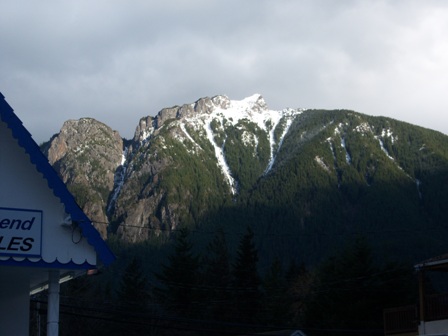
Twin Peaks High School is actually
Mt. Si High
School in North Bend, WA.
Notes from the Log Lady intros
When cable channel
Bravo
obtained the rights to air reruns of Twin Peaks
in 1993, David Lynch directed all-new introductions to each
episode featuring the Log Lady, portrayed by original
actress Catherine E. Coulson. These intros also appear as
options on the DVD and Blu-ray collections of the series.
It's possible that the Log Lady intros were inspired by the
quotes from the fictitious Book Of The Sayings Of Tsiang
Samdup which appeared at the beginning of each chapter
of the 1926 Talbot Mundy novel
The Devil's Guard,
which is known as one of the sources of inspriation for the White
and Black Lodges and dugpas (and quite probably other
elements) of Twin Peaks. In both cases, the short
statements are roughly related to the themes and events that
take place in the linked episode/chapter.
The intros feature the Log Lady in what is presumably meant
to be her
cabin home, but the set is a bit different from what is seen
of her home in
Episode 5:
"Cooper's Dreams".
The Log Lady wears the same clothes throughout the intros
for the first season. Starting at the beginning of the
second season she wears a couple different outfits. Whether
there is any particular significance to her clothing choices
is unknown.
The Log Lady wears a ring
on both her ring finger and her little
finger on the right hand. Her left hand is not clearly visible here, but in
Episode 5:
"Cooper's Dreams", we see that she also
has a wedding band on her left hand.
The Log Lady's reference to "fire" here, and that "few would
know that meaning", may refer to the same fire of the "fire,
walk with me" tattoos of Mike and BOB and the title of the
1992 follow-up film to the series,
Fire Walk With Me.
"Welcome to Twin Peaks. My name is Margaret Lanterman. I
live in Twin
Peaks. I am known as the Log Lady. There is a story behind
that. There
are many stories in Twin Peaks--some of them are sad, some
funny. Some
of them are stories of madness, of violence. Some are
ordinary. Yet
they all have about them a sense of mystery--the mystery of
life.
Sometimes, the mystery of death. The mystery of the woods.
The woods
surrounding Twin Peaks.
"To introduce this story, let me just say it encompasses the
all--it is
beyond the 'fire', though few would know that meaning. It is
a story of
many, but begins with one--and I knew her.
"The one leading to the many is Laura Palmer. Laura is the
one."
welcome to Twin Peaks.wav
I am known as the Log Lady.wav
there are many stories in Twin Peaks.wav
the mystery of the woods.wav
it is beyond the fire.wav
Laura is the one.wav
Didja Notice?
The pilot episode has a longer version of the series'
opening titles.
The bird seen at the beginning of the series' opening titles
is a Bewick's Wren according to the Twin Peaks card
set. This is an actual species of bird known to live
throughout much of the North American continent.
When the opening titles present the scene of the "Welcome to
Twin Peaks" sign, it's obviously a still shot, as the river
on the far right of the screen is absolutely still.
The story opens on the morning of Friday, February 24, 1989.
At 3:00 (and 3:25) on the Blu-ray, Josie is humming while she applies her
make-up. It's hard to tell, but possibly she is humming the
haunting Laura Palmer theme from the Twin Peaks
soundtrack. When she hears the door slam shut as Pete heads
out for a day of fishing, she turns to look in that
direction, though she can't see him. This may have been
intended as a red herring that she knew what he would find
on the shore of the lake that morning.
At 3:46 on the Blu-ray, Pete hears the foghorn and says (it's
kind of difficult to make out), "The lonesome foghorn
blows."
At 3:59 on the Blu-ray, notice that the Martell mansion has
totem polls on the outside similar to those seen later
inside
the Great Northern Hotel.
At 4:50 on the Blu-ray, a
McDonald's children's mug is blurrily seen in the
background of the Martell kitchen. A blurry Mayor McCheese
and Grimace are evident on the mug.
The sheriff of the town of Twin Peaks is named Harry S.
Truman, just like the 33rd President of the United States
from 1945-1953.
| In Lucy's first appearance of the episode,
she is wearing a sweater with diamond patterns on the
sleeves that are a bit similar to the Owl Cave glyph Cooper
will later draw on a napkin in
Episode 25:
"On the Wings of Love".
In fact, pay attention to the sweaters worn by any character
in the series...they tend to have diamond patterns similar
to the various Owl Cave glyphs seen in later episodes and in
the book
The Secret History of Twin Peaks!
Is there a hidden meaning in the diamond and triangular
shapes of the glyphs? Are the inhabitants of Twin Peaks
themselves somehow subconsciously aware of the symoblism
that they would purchase and wear clothing with a similar
motif? |
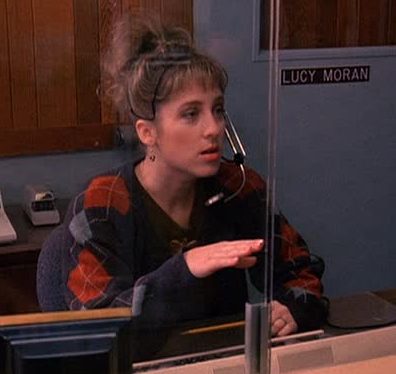 |
 |
| Lucy's sweater |
Cooper's sketch in
Episode 25:
"On the Wings of Love" |
At 4:53 on the Blu-ray, Harry pours some coffee into a Fire
King barrel mug. Fire King is a brand of the
Anchor
Hocking Company. The mug is next seen on Frank Truman's
desk in
Season Three Part 7: "There's
a Body All Right"! (Thanks to Vinnie Guidera's
article "Northwest Cupboard: The Drinkware of Twin Peaks" in
Blue Rose magazine #14.)
During Harry's phone call with Pete Martell at the sheriff's
station from 5:20-5:36 on the Blu-ray, notice that Lucy's face is
reflected in the glass of the station's entryway as she sits
at the reception desk.
After learning of the body Pete has discovered on the shore
of the lake, Harry tells Lucy to get a hold of Dr. Hayward
to meet him at the Packard Mill at the dock right below the
dam. This is presumably Black Lake Dam, depicted on the map
on the back cover of
Twin Peaks: An
Access Guide to the Town.
The building used as the exterior of the Twin Peaks
Sheriff's Department was the regional office of the
Weyerhaeuser Corporation in Snoqualmie. A large stone
with a plaque engraved with the face of a man is seen in
front of the building; this is also part of the Weyerhaeuser
office, but I've not been able to track down the identity of
the man on the plaque. Within the universe of Twin Peaks,
it may be a different person altogether!
The Twin Peaks trading card set states that the sheriff's office is
located on Highway 21 (Main Street of town), just two blocks
from Wagon Wheel Bakery, which supplies coffee and donuts to
the station. There is a route called Primary State Highway
21 in Washington made up of several different routes, but it
is located farther west than the Highway 21 depicted on the
maps found in
Twin Peaks: An
Access Guide to the Town.
| Notice that the signage of the Twin Peaks
Sheriff's Department has the same brown-with-green-border
coloring of the letters as the TV series logo (the font is a
bit different though). The "Welcome to Twin Peaks" sign at
the edge of town also has similar coloring for the words. |
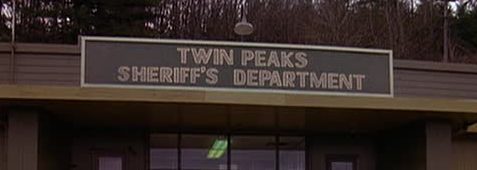 |
 |
Harry's sheriff's truck is a
1987
Ford
Bronco.
At 6:40 on the Blu-ray, notice that Deputy Andy wears his gun
on his left hip, suggesting he is left-handed, but the holster is
actually a right-handed one, as indicated by the gun-butt
being pointed to the front of his body, not the back.
Episode 2:
"Zen, or the Skill to Catch a Killer"
also shows him with the backwards holster. However, later episodes have him wearing it normally on his
right hip.
As Andy takes photographs of the body, he starts to cry at
the sight. Harry, exasperated, but gentle, chides him, "Come
on, Andy. Same as last year in Mr. Blodgett's barn." What
did they find in Blodgett's barn? Was it another murder? Or
just a natural death? Or something else?
When Andy breaks down, notice that Dr. Hayward takes the
camera from him and, as Harry speaks to Andy, we hear, but
don't see, that Hayward is finishing the picture-taking
required of the body.
At 8:17 on the Blu-ray, notice that packages of
Quaker
Oatmeal and
Cap'n
Crunch cereal are seen in the background on the kitchen
counter in the Palmer home, but the labels have been altered
to "Cereal" on the oatmeal container and "Crunchies" on the
Cap'n Crunch box! The real world brands are both owned by
the Quaker Oats Company.
Also notice that the Palmers appear to have two
microwave ovens in their kitchen! Maybe one of them is
actually a convection oven? Or it could be that the
"built-in", overhanging one ceased functioning and the
other, countertop one, was purchased to use instead
(personal note: this
happened at my grandparents' summer cabin, so it appeared
they had two microwaves!). However, Sarah in this scene, after
shouting for Laura to get out of bed and get ready for
school, turns around and twists a knob on the overhanging
oven for no apparent reason!
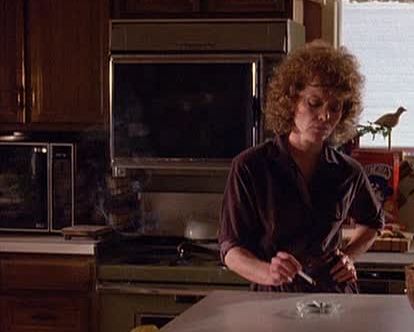
When Sarah goes upstairs to rouse (the missing) Laura out of
bed for school, notice that Laura's bedroom door and, from
the sound of it, the bathroom door are both closed. It seems
odd that the doors would closed if no one was in there.
Since Laura did not come home last night, you'd think the
doors would be open. Maybe Laura, as a typical petulant
teenager, would choose to keep her bedroom door closed all
the time to keep her stuff private, but why would the
bathroom be closed with no one in it? Did Leland/BOB close
the doors so that Sarah wouldn't realize Laura was missing
right away that morning?
In the Briggs household, notice that refrigerator magnets of
what appear to be praying figures are seen and there is a
small religious statue on the kitchen sink.
When Mrs. Briggs answers Sarah's phone call, notice that she
picks up a pair of scissors and plays with them while she
talks. This fidgeting reflex may be a trait on her side of
the family, for notice throughout the series that her son
Bobby is constantly seen fidgeting with objects. It's also
possible the scissors were put into her hands by director
Lynch, as a red herring that maybe she was the killer.
The Briggs' phone has a large 911 sticker on it. 911 is the
emergency number to dial in the U.S. and Canada.
Though Mrs. Briggs is generally referred to as "Betty",
Sarah seems to call her "Beth" during their phone call.
Possibly, her full first name is Elizabeth.
At 10:24 on the Blu-ray, notice that Mike Nelson is listening as
the high school's football coach is speaking to Mrs. Palmer
about Bobby Briggs' absence from football practice that morning.
| The sign for the Great Northern Hotel is the
actual sign for the Salish Lodge, covered with a Great
Northern design. |
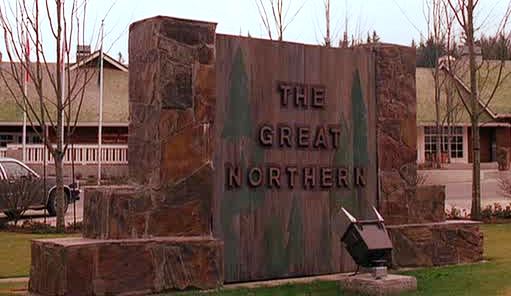 |
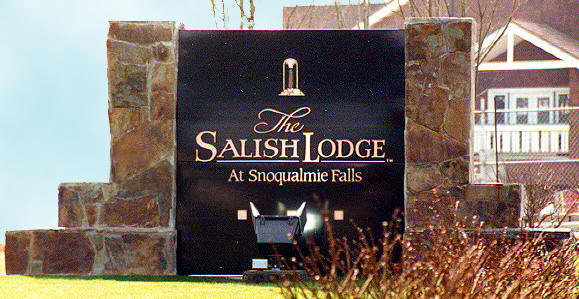 |
At 10:59 on the Blu-ray, Audrey Horne climbs into a
Mercedes-Benz 600 W100 limousine for her ride to school.
When she gets in, the triangular back-side window is rolled
up, but when she sits down, the window has suddenly been
rolled down (to give the camera a clearer shot of her
face!).
Audrey is
wearing saddle shoes when she leaves for school. When she arrives at school, she
exchanges her saddle shoes for a pair of sexy red pumps she
keeps in her locker.
Also at 10:59 on the Blu-ray, notice that the Great Northern
Hotel flies the flags of both the U.S. and Canada, as well
as the state flag of Washington.
As he and Leland Palmer are about to go into their meeting
with the Norwegian investors, Benjamin Horne tells him,
"Let's get out there and get those cheese-eaters where they
live." Norwegians are known for cheese being a large part of
their diets.
Ben Horne is attempting to get investors to build Ghostwood
Estates and Country Club in Twin Peaks. In later episodes,
we learn that the Ghostwood National Forest surrounds the
environs of Twin Peaks; this is a fictitious forest. The
actual woods in the part of Washington where Twin Peaks is
shown to be located in the
Twin Peaks: An
Access Guide to the Town book is the
Colville National Forest. Of course, "Ghostwood" refers
to the spiritual/supernatural aspects of the Twin Peaks
region in the series.
A painting of White Tail Falls (Snoqualmie Falls) is seen
hanging on the wall in the Great Northern during Ben and
Leland's meeting with the Norwegians.
At 14:55 on the Blu-ray, the phone number on the house phone at
the Great Northern is difficult to make out entirely, but
appears to be something like 924-8004. The area code appears
to be blacked out. The 924 prefix is widely used in
Washington.
The exteriors of the Double R Diner were shot at the Mar T
Cafe in North Bend, WA. The place is now known as
Twede's
Cafe.
Double R waitress Heidi drives a 1968
Volkswagen
Beetle.
At 15:38 on the Blu-ray, a sign is seen leaning against a RR
wall, "Saturday All You Can Eat Spaghetti".
| PopApostle reader Conrad S. has
identified
the make and model of the jukebox at the Double R as a
Seeburg LPC-1 (thanks for writing in, Conrad!). It has a
banner logo inside the glass proclaiming the
"Finest Stereo Albums of the Month". Some
hand-written notes on the album cover images read "Top Hit"
and the 1989 "Big Tube Squeezer" album I Have a Thing
for Love. (Close-up of the jukebox from
WelcometoTwinPeaks.com.) |
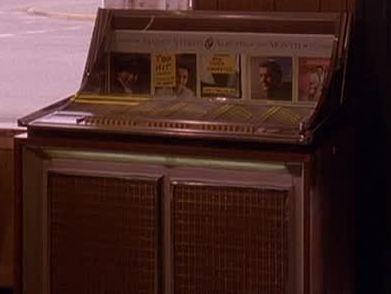 |
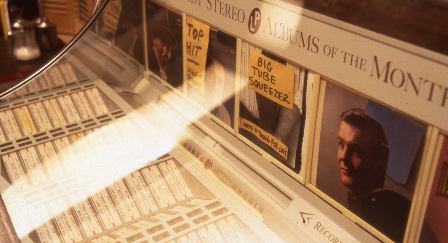 |
Shelly asks Heidi why she's late: "What kept you, Heidi,
seconds on knockwurst this morning?" This may be an allusion
to sex. When Heidi tells her she couldn't get her car
started, Shelly responds, "Too busy jump-starting the old
man, huh?" and Heidi just giggles adorably.
Heidi seems to be German and Bobby says to her, "I thought
you Germans were always on time." It seems he may be
confusing Germany with Switzerland, known for its
manufacturing of outstanding timepieces.
The selection Bobby plays on the jukebox as he's leaving is
"I’m Hurt Bad" by Angelo Badalamenti and David Lynch from
Lynch's 1989 avant-garde play, Industrial Symphony No. 1.
Bobby drives a 1969
Plymouth Barracuda. In episodes after
the two-part pilot,
he drives a 1981
Pontiac Firebird Trans Am (though
Fire
Walk With Me also has him driving the Barracuda).
In
Episode 1: "Traces
to Nowhere", Cooper, while going over the
available evidence with Truman, tells Truman they should
check out Bobby's vehicle top to bottom, so it may be that
the Barracuda was impounded for a while and Bobby had or
borrowed the Firebird as a backup vehicle.
The sheriff's vehicle seen at 17:24 on the Blu-ray is a Ford LTD
Crown Victoria, commonly used by law enforcement agencies at
the time.
Bobby tells Shelly she's "a 3-stage-rocket", "a pocket rocket."
A 3-stage rocket is one that uses three stages in
consecutive order to achieve launch from Earth to orbit. A
"pocket rocket" is a slang term for a petite, sexy woman.
During the car ride to Shelly's house, she tells Bobby that
her husband, Leo, is still on the road in his trucking job,
having called her from Butte last night. Butte presumably
refers to the city of
Butte, Montana, though it is not all
that far from the location of Twin Peaks, just 7 or 8 hours
drive.
Shelly refers to Bobby as "Mr. Touchdown", a reference to
his participation in the high school football team.
Leo Johnson's big rig truck is a
Kenworth W-900.
At 18:21 on the Blu-ray, we see that Leo and Shelly are in the
process of having an addition put onto their house. In
Episode 1: "Traces
to Nowhere", it appears to be a new (or
expanded) kitchen. It also provides a red herring that Leo may be
responsible for Laura's murder, as plastic wrapping is seen
as a barrier between the still-under-construction addition
and the original portion of the house, the same type of
plastic sheet Laura was found wrapped in.
As Bobby's car speeds rapidly away from the Johnson house
when he and Shelly realize that Leo's home already, notice
that accompanying the sound of screeching tires and revving
engine is the sound of a timber mill sawblade cutting wood.
At the hospital, just before viewing the body of his
daughter, Leland remarks that Laura was just 17 years old.
This would place her birthday in 1971 or '72 since
her death was on February 23, 1989. The Twin Peaks
card set by Star Pics, Inc. states her birthday to be July
22, 1972.
Truman refers to Leland as Lee as he tries to comfort him
after viewing his daughter's dead body.
The morgue attendant for the viewing of Laura's body by her
father is the same one who is there when Cooper and Truman
see the body later (Jim).
At 20:29 on the Blu-ray, notice that Donna does not have a lock
on her school locker. Also, notice that Audrey does not put
a lock on her locker when she finishes! They must get robbed
frequently!
At 20:39 on the Blu-ray, notice that Audrey has an ashtray in
her school locker for taking a quick, illicit smoke!
At 20:52 on the Blu-ray, a boy at the high school seems to be
side-ways-dancing to the soundtrack as he scoots off down
the hall!
At 21:00 on the Blu-ray, a word in cursive stitching can be
seen on the right sleeve of Mike's varsity jacket. It's hard
to make out, but may read "Torrance". It may be that the
prop jacket was originally one from Torrance High School in
Torrance, CA, a location which has appeared in a number of
Hollywood productions. As stated earlier, the filming
location used for Twin Peaks High School here in the pilot
was Mt. Si High School in Snoqualmie, WA.
Bobby refers to Mike as Snake. It seems to be a nickname
Mike has acquired.
At 22:25 on the Blu-ray, a picture of Abraham Lincoln is hanging
on the wall of the classroom in the background.
At 22:52 on the Blu-ray, one of the students in James and
Donna's class has a Holt Algebra book on his desk, though a
different algebra book is seen on the teacher's desk.
Holt
McDougal is an American publisher of school textbooks.
Notice that all the way up to this point in the story,
nobody has been told that Laura Palmer is dead...everyone
has intuited it from scraps of information and emotions.
Possilbly this is also a cue to the audience that not
everything in this series will be explained directly; much
of it will need to be figured out or intuited by the viewer.
For some reason, there is a Texas flag hung on the wall
above a bookcase in the school library at 23:52 on the
Blu-ray.
A poster of a whale's tail splashing out of the water is
seen on the wall of the school library at 23:58 on the
Blu-ray.
It may be the tail of a humpback whale, prevalent in the
ocean off the Washington coast in the summer.
When Bobby is informed that his girlfriend, Laura, has been
murdered, and he is under suspicion for the crime, he is
more upset about being suspected than he is that she is
dead. This is a clue (though a red herring) that he might be
the killer.
The public address system at Twin Peaks High School used by
Principal Wolchek appears to be a Cats system, but I've been
unable to confirm the brand name.
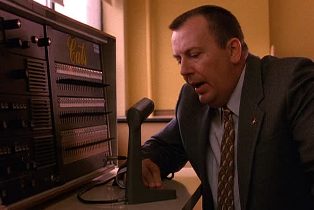
| Principal Wolchek wears an unusual
lapel pin on his sport coat. It almost looks like a cow. |
 |
At about 26:51 on the Blu-ray, as Donna is being comforted by
her friends after the announcement of Laura's death, the
blond friend almost seems to be struggling to hold back a
smile instead of having a sad look. She was probably just an
extra not used to being on camera.
At 27:18 on the Blu-ray, the trophy partially visible behind the
Laura Palmer photo in the high school's trophy case actually
appears to have "University of Washington" engraved on it.
Who is the old woman attempting to calm Sarah at the Palmer
house at 27:39 on the Blu-ray? A friend? A nurse who came to the
house with Dr. Hayward to help administer the sedative?
At 28:59 on the Blu-ray, a black-and-white framed photo of Laura
is seen behind Sarah, as well as a smaller photo of a blond
little girl that is presumably Laura as a child.
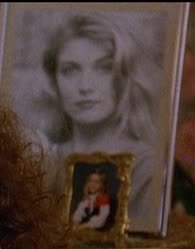
As logs are being cut and rolled at the Packard Sawmill,
notice at 31:32 on the Blu-ray that some spray-painted lettering
is seen on a wall in the background, but the lettering is
reversed; the shot must have been flipped.
The date of this episode is February 24. But the calendar in
the Packard Mill at 32:15 on the Blu-ray is only marked out
through the 19th.
The man that Catherine "fires" at the Mill is named Fred
Truax. Kind of an appropriate name for a lumberman!
At 33:38 on the Blu-ray, the police car seen at the Packard Mill
is a 1982 Plymouth Gran Fury.
James Hurley rides a 1975
Harley-Davidson Electra Glide
motorcycle.
According to
Twin Peaks: An
Access Guide to the Town, Big Ed's Gas Farm is on
Tanner Road. But the Twin Peaks card set states it
is located on Highway 21. Since the card set does have a
number of demonstrable errors in it, I'm going with the
address given in the Access Guide in this case. At 35:33 on the
Blu-ray, we see that Ed and Nadine's house is
right next to the Gas Farm and the address is
31002. This would make their home address 31002 Tanner
Road.
Ed leaves the Gas Farm to pick up Nadine's new drapes in
town. Presumably he has another, never seen, employee at the
station to mind the store. In
Episode 1: "Traces
to Nowhere", Ed mentions that his nephew James works
there with him, but we just saw James speaking to Ed and
then leaving, so there must be someone else.
FBI Special Agent Dale Cooper drives into
Twin Peaks at about 11:30 a.m., the same day that Laura's
body was found and the missing Ronette crossed the state
line. How did the FBI get him out there so quickly? It seems
he must have been in the general area already and was sent
to Twin Peaks as the closest available agent; this seems to
be confirmed in
"Diane..."
The
Twin Peaks Tapes of
Agent
Cooper, which places him in
Seattle for a fiber samples procedures seminar at the time.
Contradictorily,
The Autobiography of F.B.I. Special Agent Dale
Cooper has him being assigned the case
while in San Francisco at about 6 a.m. He could make it in
that time if he really rushed, but Ronette's crossing on the
railroad bridge seems to occur later than 6 a.m. in the
episode!
The
FBI, of
course, is the Federal Bureau of Investigation, which
investigates federal crime and provides internal
intelligence for the federal government.
Agent Cooper's rental car is a 1981
Dodge Diplomat.
As he drives into town dictating into his mini-cassette
recorder, Cooper gives the day's date
as February 24.
The Twin Peaks card set lists Cooper's middle name
as Bartholomew. This makes one abbreviation of his name
"D.B. Cooper". This was also the popular media epithet of an
unknown man who extorted a large amount of money and escaped
a jet plane in mid-flight over the woods between Seattle, WA
and Portland OR in 1971. He has never been caught or identified.
While dictating into his recorder for his secretary, Diane,
Cooper states that Twin Peaks is located 5 miles south of
the Canadian border and 12 miles west of the state line
(with neighboring Idaho). If Twin Peaks is along the
Columbia River as it's depicted in
Twin Peaks: An
Access Guide to the Town,
then the border with Idaho should be more like 20-25 miles.
But, the 12 miles might be from the eastern edge of Twin
Peaks' jurisdiction for sheriff and fire service, etc.
It can be seen right here in his introductory scene that
Cooper wears a ring on the little finger of his left hand.
The ring will go on to play a small but important part in
second season episodes. The ring is identified as one that
had belonged to his mother in
The Autobiography of F.B.I. Special Agent Dale
Cooper (though he acquired the ring in a
mysterious manner).
Cooper remarks to Diane, “As W.C. Fields would say, 'I'd
rather be here than Philadelphia'.” W.C. Fields (1880-1946)
was an American comedian and actor of both stage and screen.
A number of Fields' famous lines refer disparagingly to
Philadelphia, but he never said this one to my knowledge,
however, he
once wrote a mock epitaph for himself, "I Would Rather Be
Living in Philadelphia."
Later episodes reveal that Cooper is based out of the FBI
office in Philadelphia. However, in
The Autobiography of F.B.I. Special Agent Dale
Cooper, it seems he is still stationed
in San Francisco at this time.
Cooper remarks to Diane that he had lunch at the Lamplighter
Inn on Highway 2 near Lewis Fork. Highway 2 is a real
highway that runs through Washington and near the area of
Twin Peaks. Both the Lamplighter Inn and Lewis Fork
are fictitious.
The town's local hospital is Calhoun Memorial Hospital. In
the book Conversations With Mark Frost by David
Bushman, Frost says the hospital was named for his maternal
grandfather, Doug Calhoun, who was an obstetrician. Dr.
Hayward on the show was also largely based on him.
Cooper asks Truman what kind of fantastic trees they
have growing around there and Truman responds they are
Douglas firs. Douglas firs do, in fact, grow in the
northeastern corner of Washington and are the second-largest
conifer in the world after the coast redwood.
The doctor who is attending Ronette Pulaski is Dr. Shelvy.
Her name badge is hard to make out, but it looks like her
first name may be Laurie.
Dr. Shelvy tells Cooper and Truman that Ronette may have
neurological damage and is not responsive at all. But after
Cooper touches her hand, she begins to speak groggily. This
may suggest that Cooper has a special unconscious ability to
reach others. In
Episode 4: "The One-Armed
Man", Cooper tells Truman that he is a
"strong sender".
At 40:40 on the Blu-ray, notice that the One-Armed Man is seen
briefly on the hospital elevator with Cooper and Truman
before he exits on an earlier floor than they do. He is not
seen again until Hawk sees him and follows him briefly
before losing him in
Episode 1: "Traces
to Nowhere".
When the One-Armed Man gets off the elevator, Dr. Jacoby is
standing by the nurse's desk outside. He seems to be telling
the nurses a story about catching a big-mouthed fish that
starts talking to him! Was he relating a dream he'd had?
In this episode, Dr. Jacoby is, for some reason, wearing
some kind of corks or large plugs in his ears. Is he
undergoing treatment for some kind of hearing issue? The
plugs are not seen again after this but, in later episodes,
he is often seen wearing glasses with one red and one blue
lens (there is a pair of glasses in his medical frock here
as well, but it's hard to tell if the one partially-visible
lens is tinted). In the Twin Peaks card set, Dr.
Jacoby says the rose- and aqua-colored glasses help balance
the right and left sides of his brain.
The Secret History of Twin Peaks
goes into a little more detail about the glasses.
Also notice that Dr. Jacoby is wearing a tie featuring an
embroidered, topless hula dancer. It even appears that her
nipples are visible! And as he's telling Cooper and Truman
that Laura was "seeing him", he is actually stroking his
finger under the hula girl's skirt! It might be an
unconscious tell that he was not just seeing Laura
professionally as her therapist, but was engaged in sexual
relations with her.
In later episodes, Dr. Jacoby is
depicted as having a particular interest in Hawaii, where
hula dancing originated, even once mentioning having a wife
there, whom we meet briefly in
Episode 10:
"The Man Behind Glass". The Twin Peaks card set states that he
attended school at Punahou School in Hawaii and the
University of Hawaii Medical School and placed third in
the interscholastic surfing competition during his senior
year of high school, all suggesting he grew up in the island state.
Punahou
School is a private K-12 school in Honolulu (which 44th
U.S. President Barack Obama also attended!).
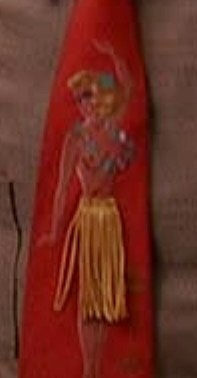
When Truman introduces Agent Cooper to Dr. Jacoby, the good
doctor mishears the name as "Gary Cooper". Gary Cooper
(1901-1961) was an extremely popular Hollywood actor from
1925 onward.
Dr. Jacoby is seen to wear a large ring on his right hand in
this episode. It looks like it may be a skull ring!

When Cooper examines Laura's body in the hospital morgue,
the fluorescent lights there keep flickering. This may be
indicative of the presence of a spirit from the Black Lodge,
as they seem to travel via electricity and cause similar
disruptions in the 1992 follow-up film to the series,
Fire Walk With Me.
(Behind the scenes, the flickering was unintentional, but
Lynch liked it and made it part of the scene rather than fix
it or work around it.)
The morgue attendant is named Jim.
When Cooper discovers the small letter "R" under the
fingernail of Laura's ring finger, he removes it and records
a message to Diane, "Diane, give this to Albert and his
team, don't go to Sam. Albert seems to have a little more on
the ball." Albert Rosenfield appears in some later episodes.
In Fire Walk With Me, we meet Sam (Stanley) during
the investigation of the Teresa Banks murder in 1988 (in
which the letter "T" was found under the nail of her ring
finger). Despite Cooper's review here, Sam seems to be
pretty competent in the film, though a bit green and
gullible. (The Secret History of Twin Peaks
states that Sam was placed on administrative leave after
returning from Deer Meadow and that he had possibly developed
an alcohol problem.)
Notes from the Mark Frost interview on the Season
One Blu-ray boxed set
Cooper was intended as a modern day Sherlock Holmes.
Actor Robert Forster (1941-2019) was almost cast as Sheriff Truman, but
he had a prior obligation to another series pilot at the
time the Twin Peaks pilot was scheduled to shoot.
Forster later went on to be a part of the Twin Peaks
season three on Showtime in 2017.
Notes from the Twin Peaks card set published by Star
Pics, Inc. (1991)
(The card images and reverse-side information can be perused
online at
LynchNet.com.)
Card #1: By the end of the second season of the series,
Truman has been the sheriff for 6 years.
Card #4: Cooper was born on April 19, 1954, attended
Haverford College and the
FBI Academy, and was an Eagle
Scout who scored a perfect 100 on his marksmanship test.
Card #8: Truman was Assistant Sheriff before he became
Sheriff. Tours of the Sheriff's Station are available on
Tuesdays.
Card #9: Truman was born on May 13, 1950. He was educated at
Twin Peaks High School and
Washington
State College. The book
Twin Peaks: An
Access Guide to the Town states that he is fond of
Oriental dishes; this is a tongue-in-cheek reference to his
relationship with Josie Packard.
Card #10: Deputy Andy was born February 27, 1960.
Card #11: Lucy Moran was born May 27, 1962. She attended
Tacoma High School and Mrs. Smith's School of Secretarial
Science (both seem to be fictitious schools). She was
Employee of the Year in 1988 at the Twin Peaks Sheriff's
Office. (Since Lucy attended Tacoma High School, it suggests
she did not grow up in Twin Peaks, so what brought her there
in the first place?)
Card #12: Hawk was born September 16, 1950. He attended Zuni
Reservation High School (this appears to be a fictitious
school). Hawk is a champion at the one-armed ax throw at the
Packard Timber Games. (The Zuni Reservation exists mostly in
New Mexico, with small portions in Arizona, so Hawk is
apparently not a native of the Twin Peaks area; however,
The Secret History of Twin Peaks states that
Hawk is a full-blooded Nez Perce, a tribe native to the
northwest.)
Card #14: Laura Palmer liked potato pancakes with creamed
corn topping (creamed corn later becomes a symbol of
garmonbozia, the pain and sorrow that residents of the
Black Lodge feed on). For her twelfth birthday, she got a pony and
named it Troy; she won a blue ribbon at the National Riding
and Jumping Derby. James was teaching her to ride a
motorcycle before her death. The card also incorrectly
states that Laura was Prom Queen at Twin Peaks High School;
she was Homecoming Queen.
Card #16: James Hurley was born January 1, 1973.
Card #17: Dr. Jacoby was born January 30, 1934.
Card #18: Of Laura's two diaries, the "secret" one is the
one that was given to her by her parents on her 12th
birthday. But shouldn't the one her parents gave her and,
therefore, know about, be the "official" diary and the
other one (which looks different) have been the secret one?
Card #19: Dr. Hayward was born on May 25, 1929 (actor Warren
Frost was born on May 25 as well, 1925). He attended the
University of Washington and the
University of Washington Medical School. He is a past
president of the Northwest Chapter of the
American Medical Association and served on its national
committee for the study of euthanasia. (According to
Twin Peaks: An
Access Guide to the Town, he first graduated from the
University of Minnesota).
Card #20: Donna Hayward was born on September 2, 1972. She
has been on the high school honor roll for all four years
and her senior class voted her most likely to succeed.
Card #21: Mrs. Tremond's grandson, Pierre Tremond, was born
January 10, 1983. He attended Twin Peaks Elementary School
and claims to be one of the youngest Master Magicians who
can make himself disappear. He detests yellow food,
particularly creamed corn.
Card #22: Madeleine Ferguson was born June 22, 1968 and
attended Missoula High School in Montana. (There is no
actual high school in Missoula by that name.)
Card #23: Pete Martell was born June 28, 1934 and attended
Missoula High School in Montana. (There is no actual high
school in Missoula by that name.) He is the perennial winner
of the Twin Peaks Chess Tournament, held each year during
the Packard Timber Games.
Card #25: Catherine Martell was born November 20, 1940 and
attended Twin Peaks High School. Her mother was active
civically and Catherine followed suit, serving on the Twin
Peaks Town Council for 13 years and was president of the
United
Way for two terms. She speaks fluent Japanese and
French.
Card #27: The Packard family was one of the original
founding families of Twin Peaks and have lived in Blue Pine
Lodge for three generations.
Card #28: Josie Packard was born September 2, 1962 (also
confirmed in the
Twin Peaks: An
Access Guide to the Town). She
attended Fujimoto High School in Japan (I've been unable to
confirm a school by that name in Japan). She was the youngest
female CEO in the timber industry.
Card #29: It is implied that the road through town
frequently referred to as Sparkwood is officially Sparkwood
Mountain Road.
Card #30: The female pine cones of the Douglas fir tree grow
on the upper branches, while the male cones grow on the
lower and the wind blows the seeds/pollen from one to the
other. (This is basically true of all pine trees. Perhaps
the fertilization process was the inspiration for the shots
of wind blowing the trees as seen throughout the TV series?)
The card goes on to state the pine cone is the official Twin
Peaks flower. (However, pine cones are not scientifically
considered to be a true flower.)
Card #31: The RR Diner is stated to be located on Highway J,
down the street from Horne's Department Store. In
Twin Peaks: An
Access Guide to the Town, the restaurant is shown on
Falls Avenue on a map (though text within the book also
states the RR on Highway J). It's possible that Falls Avenue
doubles as a portion of Highway J, but the card also states
the diner is just down the street from Horne's Department
Store, which is depicted a few blocks away, on Maple Avenue
and Snow Street in the Access
Guide. The diner's owner, Norma Jennings, bakes fruit pies for Eagle Scout
Troop #294's annual July 4th pie-eating contest.
Card #32: Norma Jennings was born September 30, 1950. She
attended Twin Peaks High School and Twin Peaks Community
College. She was Miss Twin Peaks in 1969 and the 1987 Twin
Peaks Chamber of Commerce Small Business Owner of the Year.
Card #34: Shelly Johnson was born May 30, 1972. She attended
Twin Peaks High School for two years and never graduated,
presumably dropping out to marry the older Leo Johnson.
Card #35: Leo Johnson was born April 25, 1968. He attended
Twin Peaks High School and MTA Truck Drivers School. MTA
Truck Drivers School was an accredited home study school (it
appears they are no longer in business).
Card #36: Bobby Briggs was born December 10, 1972.
Card #37: Ed Hurley was born October 26, 1950.
Card #42: The Log Lady (Margaret Lanterman) attended Twin
Peaks High School and Evergreen State University, WA. Her
birth date is unknown. She is
a former candy striper (volunteer hospital worker) and is a
nature docent (teacher) with the Twin Peaks Wilderness
Society. (Evergreen State University is probably referring
to
Evergreen State College in Olympia, WA.) The
Twin Peaks: An
Access Guide to the Town says that she is a self-proclaimed Libra,
which, if true, would make her birth date within September
23-October 23.
Card #43: The Log Lady's log is from a Ponderosa Pine. It
was given to Margaret by her former woodsman husband as a
wedding gift. (Episodes of the series generally hint that
the spirit of Margaret's dead husband resides in, or communicates
through, the log.) However,
The Secret History of Twin Peaks
states that the log is from a Douglas fir and that she took
the log from a fallen tree after the forest fire that killed
her husband.
Card #44: The Roadhouse is said to be down the road from Big
Ed's Gas Farm and very close to the Bookhouse (a shot
Episode 0B: "Northwest
Passage" shows that the Bookhouse is just
on the other side of the parking lot from the Roadhouse!). But
Twin Peaks: An
Access Guide to the Town, shows it on a different
street than the Gas Farm.
Card #45: One-Eyed Jack's is on the northwestern shore of
Black Lake, on the Canadian side of the border. Live
"entertainment" is provided by the "52 Pick-Up Girls".
(Gambling and prostitution, the business of One-Eyed Jacks,
is permitted in Canada, regulated by each of its provinces
and territories; "52 Pick-Up" is a reference to a card deck,
which typically has 52 cards.)
Card #46: Benjamin Horne was born August 4, 1940. He
attended Twin Peaks High School and
Stanford
University. He was president of the
Sigma Alpha
Epsilon fraternity at Stanford and later served on the
Washington Governor's Special Advisory Board for Trade and
Development. (From what I can tell, there is no chapter of
the Sigma Alpha Epsilon fraternity at Stanford; it is
interesting to note that the fraternity is the only
currently existing one that originated in the Antebellum
South, possibly explaining Ben's psychotic break into
believing he was Confederate General Robert E. Lee seeking
to defeat U.S. General Ulysses S. Grant during the Civil War
as depicted in several episodes of the second season.)
Card #47: Audrey Horne was born August 15, 1972. She is
president of the French Club at Twin Peaks High School.
Card #48: Jerry Horne was born December 4, 1945. He attended
Gonzaga
University and
Gonzaga University Law School in Washington. In
Episode 15:
"Drive With a Dead Girl",
Cooper adds that Jerry graduated last in his class there in
1974.
Card #50: Dick Tremayne was born March 23, 1960. He attended
Eton College.
Eton
College is a boarding school in England, founded in 1440
by King Henry VI.
Card #51: The Great Northern Hotel was founded by the Horne
family in 1927. The hotel has 102 guest rooms, all furnished
with queen-size, goose down mattresses designed by the E-Z
Mattress Company of Seattle. (As far as I can determine, the
E-Z Mattress Company is fictional and also has no other
mention in Twin Peaks.)
Card #52: The waterfall next to the Great Northern Hotel is
Whitetail Falls, described as the third highest waterfall in
the U.S., with a longer drop than Niagara Falls, but not as
wide. (In the real world, Waihilau Falls, Hawaii is the
third highest waterfall in the United States. In the
continental United States, the third highest is Yosemite
Falls, California. The actual waterfall that stands in for
Whitetail Falls, Snoqualmie Falls, does not come close to
being anything like one of the highest falls, at just 268
feet. From the shots of the falls outside the Great
Northern, it should be obvious that, while beautiful and
impressive in its own right, Whitetail Falls is not
particularly huge by any stretch of the imagination.)
Card #54: Jean Renault was born April 1, 1940. He attended
Quebec Reform School. (Quebec Reform School appears to be a
fictitious institution.)
Card #55: The Giant is a messenger of truth who comes from
the place where the spirits that rule man and nature reside.
He can only be seen by those who believe.
Card #57: Phillip Gerard (the One-Armed Man) was born
February 6, 1938. He attended Spokane Vocational/Technical
High School. (Spokane Vocational/Technical High School
appears to be a fictitious institution.)
Card #58: BOB's birth date is listed as "From the beginning
of time," and BOB states, "I have survived as long as man
has been on earth."
Card #59: Leland Palmer was born February 26, 1944. He was
educated at the University of Washington and the
University of Washington Law School. As a third year law
student, he was editor of the
University of Washington Law Review.
Card #60: Sarah Palmer was born March 3, 1946. She attended
Missoula High School, MT and the
University of
Montana. She was the president of the local bridge club
until the death of her daughter. (As mentioned in the Maddie
card entry earlier, there is no actual high school in
Missoula by that name.)
Card #63: Albert Rosenfield was born September 13, 1956. He
attended Yale
University, where he graduated first in his class, and
the FBI Academy.
Card #64: Major Briggs was born January 3, 1938. He attended
Boys High School in New York City and the
Virginia
Military Institute. He flew a twin engine plane solo
when he was just 8 years old. He is adept at speed reading.
(Boys High School, NYC is possibly meant to refer to the
former Boys High School, Brooklyn, NY.)
Card #65: Owls can represent both wisdom and evil. In Twin
Peaks, owls appear whenever UFO sightings are made. On July
25, 1986, Laura Palmer was almost killed by an owl and she
was frightened of the owls she saw in the woods.
Card #67: It is incorrectly stated that Windom Earle was
sent to Twin Peaks to to conduct an FBI Internal Affairs
investigation on Cooper!
| Card #68: |
|
Cooper's middle name is
Bartholomew. |
|
Laura's favorite
drink at the RR Diner was a brown cow; the card
describes the drink as cola and vanilla ice cream,
but a brown cow traditionally refers to a root beer
float made with chocolate ice cream. |
|
The Log Lady's husband died
fighting a forest fire. (This is also confirmed in The Secret History of Twin Peaks.) |
|
Cooper grew up in
Philadelphia, PA. (This is also confirmed in
The Autobiography of F.B.I. Special Agent Dale
Cooper.) |
| Card #70: |
|
The namesake two mountains
of Twin Peaks are Whitetail Mountain and Blue Pine
Mountain. (Both appear to be fictitious.) |
|
The Twin Peaks High School
mascot is a steeplejack. |
|
The town newspaper is the
Twin Peaks Gazette. (This was also the name
of the official fan club magazine while the TV
series was on.) However, The Secret History of Twin Peaks
relates that the name of the paper was changed to
the Twin Peaks Post in 1970. |
Notes from the Bonus Features on the Twin Peaks
Blu-ray Gold Edition set
Jake Morrissey is the owner of both the Bookhouse and
the Roadhouse. Jake is also mentioned as the owner of the
Bookhouse in
The Secret
Diary of Laura Palmer.
The exteriors of the Blue Pine Lodge were shot at
Kiana
Lodge, Poulsbo, Washington.
Unanswered Questions
"Sheriff" is a title normally given to the person who is
elected or appointed the highest law enforcement officer of
a county or parish, which would seemingly apply to Sheriff
Truman. So, what county is Twin Peaks in? In the real world,
the part of the map shown as the location of Twin Peaks in
Twin Peaks: An
Access Guide to the Town, is Stevens County, though in
the TP universe, it might be something else. The Stevens
County identification is somewhat supported by Lucy's remark
in
Episode 2: "Zen, or the Skill to Catch a Killer" about
being in the "tri-counties"; the Stevens, Pend Oreille, and
Spokane counties are often referred to as the tri-county
area of Washington's northeast corner. However, the
Ghostwood Estates contract signed in
Episode 7:
"The Last Evening", states the development to be
built in Twin Peaks County!
Memorable Dialog
wrapped in plastic.wav
too busy jumpstarting the old man.wav
I want those drapes up by nightfall.wav
entering the town of Twin Peaks.wav
never seen so many trees.wav
damn good food.wav
shouldn't be too hard to remember that.wav
a clean place, reasonably priced.wav
I've got to find out what kind of trees these are.wav
what kind of fantastic trees.wav
Back to Twin Peaks
Episode Studies